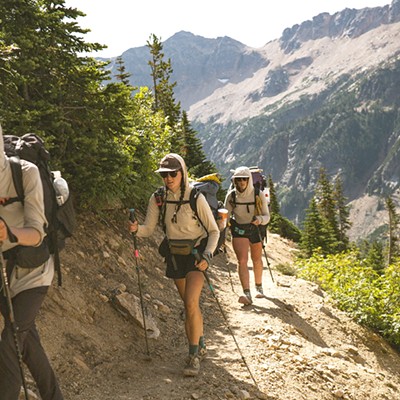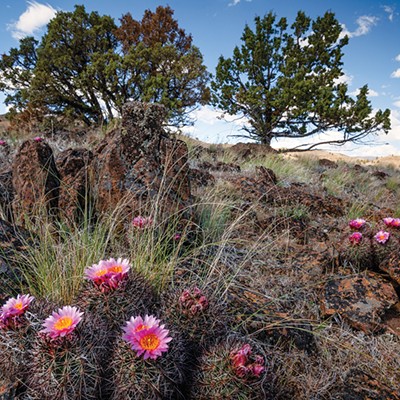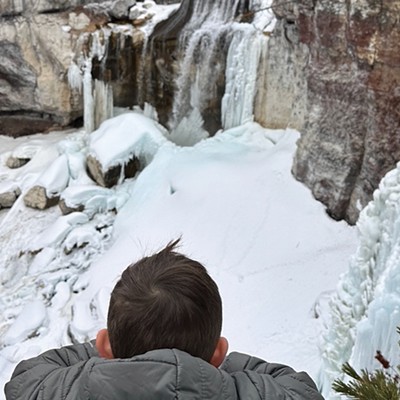Puffy coats and wool beanies at belay stations. Handwarmers tucked into chalkbags. Thin socks in shoes a half size larger than normal. Sun on south facing rock. Thermoses filled with hot tea. Classic lines with no crowds, and temperatures perfect for sending. Welcome to central Oregon winter rock climbing.
While many locals have been busy deriding the weather for a lack of snow, a few have taken to celebrating the recent high pressure for its resulting extension of the fall climbing season at Smith Rock and local bouldering areas.
Climbers prepared to suffer the relatively small and short-lived discomforts of frosty mornings and early darkness are reaping huge rewards in the form of 50 degree air temperatures, sun-warmed rocks, a noticeable lack of greasy hold and walk-on access to routes that in the summer have parties stacked up for hours waiting a turn.
"Most folks think summer is climbing season at Smith Rock, but that is definitely not the case," said Chris Wright, a certified American Mountain Guide Association Rock and Alpine guide for Timberline Mountain Guides. "If the sun is shining it's almost never too cold to climb."
Smith Rock State Park offers more than a thousand bolted and traditional rock climbing routes that range in difficulty from scrambles that ask for little more than deft feet and the occasional hand-hold for balance, to big lines that require Spiderman like abilities and hand strength that would make a dentist cry. During the summer, climbers swarm across the entirety of the 600-plus-acre park, however, soaring midday temperatures often force parties toward the shaded west-side crags or into the lower gorge basalt areas.
Winter climbing offers an escape from all of that, and also takes the necessity of early starts and endless chalk off the table.
"The south facing routes that can usually only be done in the morning or evening in July, are viable options throughout the day," Wright said. "If you're wanting to get on popular routes like Five Gallon and Ten Gallon Buckets now is a great time to be out there. There are very few lines, and the rock is in near perfect condition."
More than 400,000 people visit Smith Rock annually with most arriving at the park between May and September. The rest of the year the area's welded Tuft spires, and curving dirt packed trails are largely unoccupied, resulting in a quiet and serene atmosphere.
At this time of year you can feel like you have the park to yourself, said Wright. People will often see temperatures below freezing in town and assume it will be miserable at the crag, but it's relatively common for it to be 20-30 degrees warmer in the park than it is in Redmond or Bend. Fifty degree, sunny days are relatively common.
Visitors to the park should be aware that fewer people in the park overall means fewer people available to help if an accident occurs. There are a smaller number of climbers in the area available to act as a resource if things go wrong, heightening the need for climbing parties to be knowledgeable and self reliant, said Wright. And while many days start off sunny and remain beautiful, extreme weather can occur in the park resulting in rapidly changing conditions that climbers need to be prepared for with extra layers and survival gear.
Wright recommends climbers pursue routes on the front side of the park. For climbers seeking to tick a few classic and/or harder routes off their lists, that means lines like Churning in the Wake, 5.13, and Magic Light, 5.11,on the Morning Glory Wall. The classic multi-pitch Zebra-Zion, 5.10, is also a viable option, however temperatures higher up the wall will be colder and the climbing will likely be less comfortable.
"Sending temperatures don't happen in July, and it's a perfect time of year to push abilities and grades on fun sport routes," said Wright.
Outside of Smith Rock, climbers have numerous bouldering options throughout central Oregon. Hidden, secret stashes of climbable boulders dot the high desert, and often they're located in areas with good sun exposure and protection from the wind.
Ice climbing can also be an option, however, the region's ice is largely transitory. Ice does form at Cougar and at Paulina, where climbers often set-up top ropes before swinging their tools, said Wright. As the weather changes, and eventually it will, climbers looking for a more winter-oriented experience can head into higher regions to chase the alpine. Several of the Cascade peaks have hidden pockets of ice and technical mixed climbing that can be worth exploring.






















